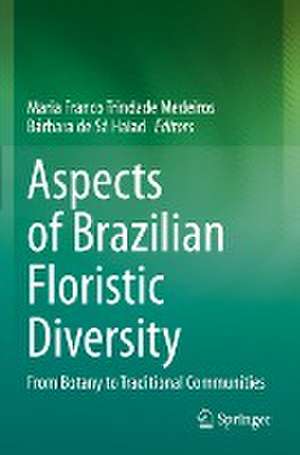Aspects of Brazilian Floristic Diversity: From Botany to Traditional Communities
Editat de Maria Franco Trindade Medeiros, Bárbara de Sá Haiaden Limba Engleză Paperback – 31 oct 2023
Aspects of Brazilian Floristic Diversity: From Botany to Traditional Communities offers a unique approach in floristic diversity of the Neotropical region, specifically encompassing the Brazilian flora. This volume combines both theoretical and applied aspects of scientific making knowledge in different perspectives of Botanical Science. In this volume, botanical specialists discuss the many different approaches of taxonomic, reproductive, ecological and ethnobotanical aspects of Brazilian floristic diversity, thereby enlightening the global interest in Neotropical species, in particular those from the Brazilian territory. The book addresses relevant questions from many points of view, including anatomy, reproduction, palinology, conservation and ethnobotany, creating an in-depth perception of the flora in its complexity constitution.
The book provides a comprehensive outlook on Botany Sciences, considering the history and traditional knowledge of plants, and relating it to contemporary problems and concerns of flora conservation today. With this current perspective, this book reaches a vast audience from the research lines of Botany, and encompasses a broader and interdisciplinary understanding of Aspects of Brazilian Floristic Diversity.
| Toate formatele și edițiile | Preț | Express |
|---|---|---|
| Paperback (1) | 1107.73 lei 6-8 săpt. | |
| Springer International Publishing – 31 oct 2023 | 1107.73 lei 6-8 săpt. | |
| Hardback (1) | 1113.89 lei 6-8 săpt. | |
| Springer International Publishing – 31 oct 2022 | 1113.89 lei 6-8 săpt. |
Preț: 1107.73 lei
Preț vechi: 1350.89 lei
-18% Nou
Puncte Express: 1662
Preț estimativ în valută:
211.100€ • 219.64$ • 176.92£
211.100€ • 219.64$ • 176.92£
Carte tipărită la comandă
Livrare economică 21 martie-04 aprilie
Preluare comenzi: 021 569.72.76
Specificații
ISBN-13: 9783031074554
ISBN-10: 3031074556
Pagini: 268
Ilustrații: XXIV, 268 p. 49 illus., 42 illus. in color.
Dimensiuni: 155 x 235 mm
Greutate: 0.41 kg
Ediția:1st ed. 2022
Editura: Springer International Publishing
Colecția Springer
Locul publicării:Cham, Switzerland
ISBN-10: 3031074556
Pagini: 268
Ilustrații: XXIV, 268 p. 49 illus., 42 illus. in color.
Dimensiuni: 155 x 235 mm
Greutate: 0.41 kg
Ediția:1st ed. 2022
Editura: Springer International Publishing
Colecția Springer
Locul publicării:Cham, Switzerland
Cuprins
Flowering phenology in a restinga community: seven years of study.- Dioecy: the dimorphic sexual system and pollination in restinga vegetation.- Male and female sterility in flowering plants.- Broad-scale variation of phytoplankton richness in Brazilian inland waters.- The Importance of Palynology to Taxonomy.- Ecological Palynology.- Scientific Exploration Commission (1859-1861): Freire Allemão and the invisible network of collaborators.- The former Imperial Plant Nursery of Quinta da Boa Vista.- Medicinal plants used in Quilombola communities in Piranga, State of Minas Gerais, Brazil.- From mulungu to mamulengo”: The sharing of knowledge among teachers, academic researchers and mamulengueiros (traditional puppeteers) in a participatory workshop.- Biocultural heritage through museological narrative as a way of return on research in historical ethnobotany.- Conclusion of the reflections on Aspects of Brazilian Floristic Diversity:From Botany to Traditional Communities.
Notă biografică
Maria Franco Trindade Medeiros, graduated in Biological and Environmental Sciences, Master's and PhD in Biological Sciences (Botany) and Postdoctoral fellow in Botany and Ecology. Educator at Pontifical Catholic University of Rio de Janeiro (2012), Federal University of Campina Grande (2013-2018) and National Museum/ Federal University of Rio de Janeiro (since 2018), belonging to its Department of Botany and Postgraduate Program in Biological Sciences (Botany). She has held the Secretariat and Presidency of Brazilian Society of Ethnobiology and Ethnoecology (2009-2010, 2011-2012) and representative of the Ethnobotany Group of the Botanical Society of Brazil (2015-2017). She promoted scientific exhibitions in the Monasteries of São Bento, Brazil (Olinda – PE, 2011; Rio de Janeiro – RJ, 2013) and another one during the National Congress of Botany (Santos – SP, 2015), with the exhibition of items of biocultural collections of some institutions. Her interdisciplinary perspective of investigation searches for a dialog between Ethnoscience, with emphasis on Ethnobotany, History, Museology, Education and Biocultural Heritage.
Bárbara de Sá Haiad is a professor at the Botany Department and at the Postgraduate Program in Biological Sciences (Botany), National Museum/Federal University of Rio de Janeiro (UFRJ), supervising Undergraduate, Master's, and Doctoral students. She holds a degree in Biological Sciences (Ecology) from the Federal University of Rio de Janeiro, a master’s degree and a PhD in Biological Sciences (Botany) from the same University, and a Postdoctoral fellow in Plant Secretory Structures at the São Paulo State University. She is interested on embryophyte morphology, with emphasis on reproductive axis’ anatomy, mainly on floral anatomy, development and floral secretory structures.
Textul de pe ultima copertă
Aspects of Brazilian Floristic Diversity: From Botany to Traditional Communities offers a unique approach in floristic diversity of the Neotropical region, specifically encompassing the Brazilian flora. This volume combines both theoretical and applied aspects of scientific making knowledge in different perspectives of Botanical Science. In this volume, botanical specialists discuss the many different approaches of taxonomic, reproductive, ecological and ethnobotanical aspects of Brazilian floristic diversity, thereby enlightening the global interest in Neotropical species, in particular those from the Brazilian territory. The book addresses relevant questions from many points of view, including anatomy, reproduction, palinology, conservation and ethnobotany, creating an in-depth perception of the flora in its complexity constitution.
The book provides a comprehensive outlook on Botany Sciences, considering the history and traditional knowledge of plants, and relating it to contemporary problems and concerns of flora conservation today. With this current perspective, this book reaches a vast audience from the research lines of Botany, and encompasses a broader and interdisciplinary understanding of Aspects of Brazilian Floristic Diversity.
Caracteristici
Offers a multidisciplinary approach to Brazilian floristic diversity research Addresses theoretical and applied aspects of scientific knowledge on Brazilian floristic diversity Chapters are sequenced in sections which act as a thematic guide to the various areas of Botany
